10 Best Monasteries in Spain to Visit or Stay in 2024
Disclaimer: This article may contain affiliate links. If you make a purchase after clicking a link, I may receive a small commission at no cost to you.
As one of the most beautiful countries in the world, Spain is filled with infinite historical treasures—including almost 750 monasteries!
Although it’s most known for its beaches, lively nightlife, food, and festivals, there’s really more to Spain than meets the eye.
Indeed, this awesome country has a rich religious, political, and military history.
When walking the Camino de Santiago a few years ago, I came across many churches, monasteries, and convents to visit—and even stay in!
It was on that trip that I began to learn more about monastic culture and deeply-rooted religious traditions in Spain. I dug deeper and found out just how many monasteries there were—and still are—in Spain.
While some monasteries in Spain, like the famous Montserrat Monastery, are located in or near cities, others may take a little more exploring off the beaten path to get to.
But, one thing’s for certain—if you want to slow down a bit, dive deeper into Spain’s religious and political-historical roots, and discover centuries-old architecture and art, a visit to Spain’s best monasteries is just the ticket!
10 Best Monasteries in Spain
Throughout the country, there are many monasteries for visitors seeking a visit on the quieter side of tourism. Scroll down for the best monasteries to travel to in Spain!
1. Santa María de Montserrat Monastery, Catalonia

Sitting among the most interesting geological formations in Catalonia is the cliffside Monestir de Montserrat (Montserrat Monastery).
Likely the most famous monastery in Spain, the Benedictine monastery was first constructed in the 11th century. However, the beautiful Montserrat abbey you see today was reconstructed in the 18th & 19th centuries after fires destroyed a part of it.
The Montserrat Spain monastery has also been a pilgrimage site for Catalans for a millennium, with locals visiting the statue of La Moreneta (the Black Virgin), the patron saint of Catalonia to receive a blessing.
At present, several dozen nuns inhabit the monastery and run both a library and the Escolania de Montserrat. This boys’ choir is the oldest choir school in Europe (circa 1200). You can hear the choir’s performance at 1 pm, daily.
Don’t forget that Montserrat sits high in the mountains at 2362 ft (720 m). To get the most of out the monastery and surroundings, book a day tour and hike with a funicular ride to its peak, Sant Joan. From there, you can enjoy stunning views of Catalonia.
2. Royal Monastery of San Lorenzo del Escorial, Madrid
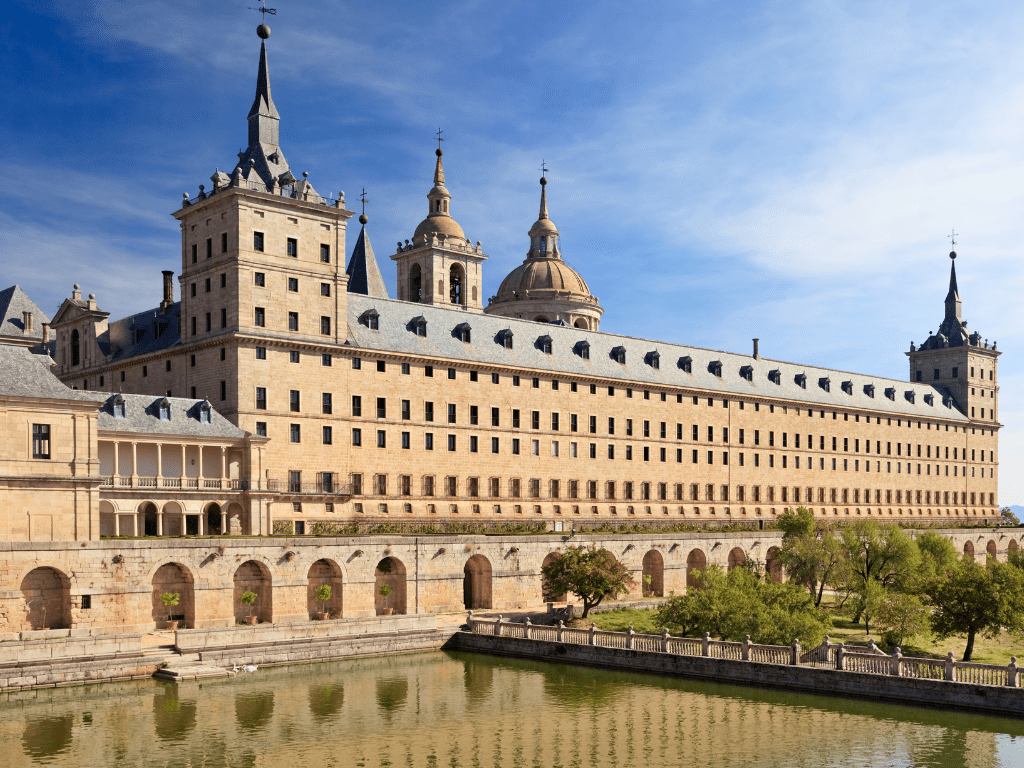
A must-do day trip from Madrid, El Escorial is a massive Renaissance complex. King Felipe II commissioned it in the 16th Century as a monument to, well, himself!
In this UNESCO World Heritage Site at the foot of Sierra de Guadarrama mountains, you’ll find both a palace and a monastery, a library, a basilica, a pantheon, and a mausoleum.
The enormous complex exemplifies a gridiron scheme as a tribute to San Lorenzo, the patron of the building. (Regrettably, he was martyred on a grill.) With the influence of several architects from the area, it took over 20 years to complete the plans.
Inside, you’ll find the most amazing frescoes painted by Spanish Renaissance artists.
In addition, you’ll hear El Escorial is the final resting place for most of the monarchs that came after Ferdinand and Isabella. Interestingly, there’s only space for two more royals — it’s anyone’s guess what will happen with future royals.
3. Royal Monastery of Santa María de Guadalupe, Extremadura
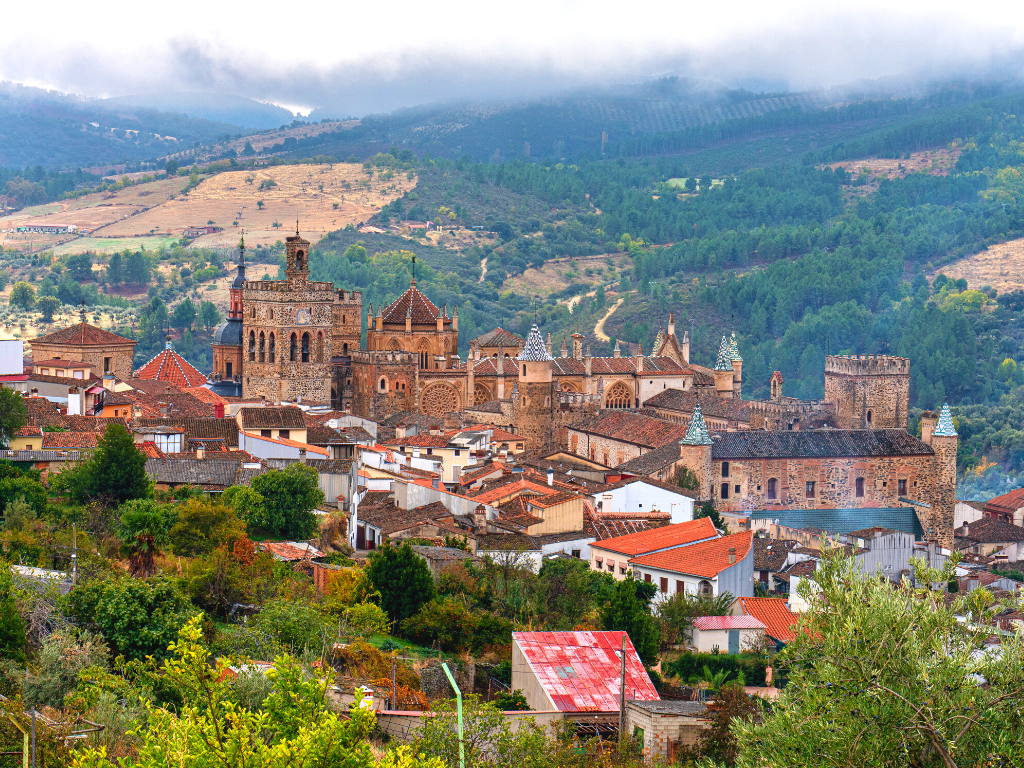
Located in the Extremaduran town of Guadalupe, the Real Monasterio de Nuestra Señora de Guadalupe is a spectacular Gothic monastery that played an important role in Spain’s history. It’s said that Catholic Monarchs and Christopher Columbus finalized plans for his journey to the New World at the monastery which is a now UNESCO World Heritage Site.
Construction on The Monastery of Guadalupe began in the 13th Century. Thus, the outside is mostly Gothic. However, the monastery itself as well as the decor inside spans the ages, and includes Renaissance, Baroque, Mudejar, and Neoclassic styles. You’ll also find the remains of some of the most important Spanish kings of medieval times.
Do note that the Guadalupe monastery only offers guided tours, mostly in Spanish. You’ll want to book in advance for English tours.
If you’re looking for a monastery you can stay in, you’re in luck. Hospederia del Real Monasterio offers a peaceful stay in its renovated rooms, complete with air-conditioning/heating, modern facilities, and free parking.
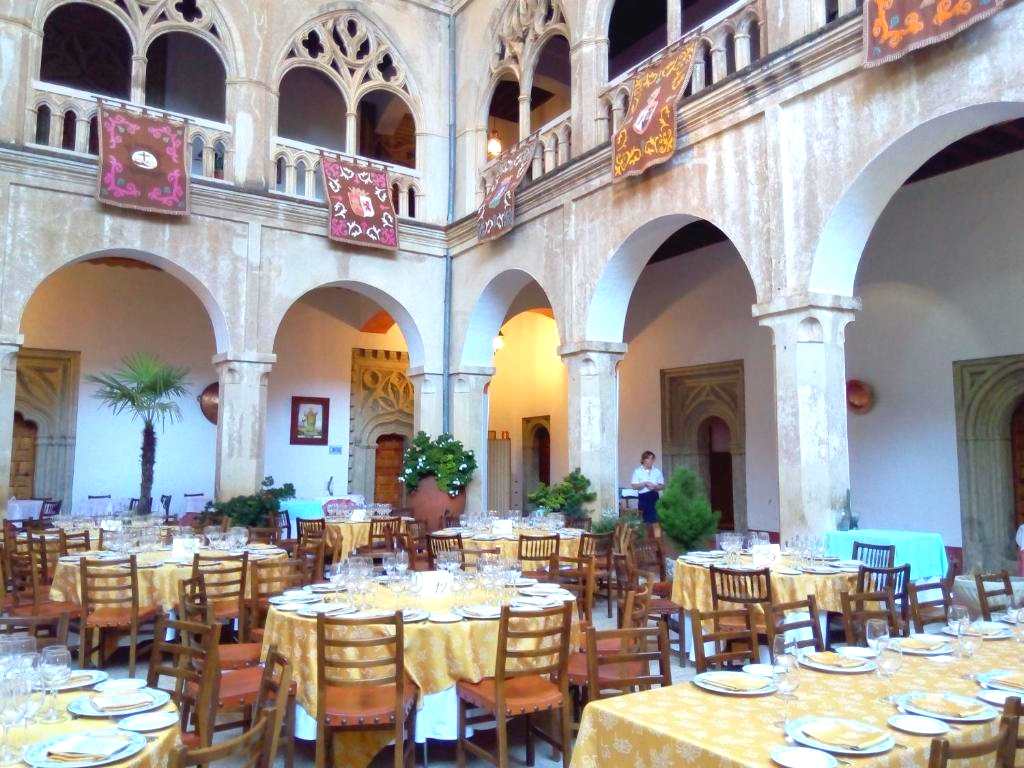
Stay at the monastery in Guadalupe!
✔ Modern
✔ Mountain views
✔ Free parking
Book now
For a once in a lifetime monastery stay, we suggest that you book a room with high ceilings, stone walls, and a view of the Sierra de Guadalupe Mountain Range.
The hotel restaurant and bar are excellent and serve classic Extremaduran cuisine in the most divine atmosphere.
When you’re ready to leave the monastery and explore the surroundings, the reception will be happy to offer advice on long country walks and the best shops and sites in the village.
Hospederia del Real Monasterio Reviews
“Exquisite setting, spacious rooms, and very quiet grounds. The adjacent church is definitely worth a visit!” — Benedict
“The views from the monastery & hotel frontage were spectacular.” — Robert (Read more reviews)
4. Santo Domingo de Silos, Castile and Leon

The Monastery of Santo Domingo de Silos is a Benedictine monastery-turned-museum founded all the way back in the 7th Century!
Located in Soria, Castilla y Leon, this is one of most well known monasteries in Spain. Its stunning Romanesque architecture is undoubtedly worthy the praise it receives.
The building itself is the destination, with its lovely cloister. Here, you’ll find the life of Christ depicted on the head of each pillar. Inside the two-level indoor patio is a huge cypress tree standing 82 ft (25 m) high!
✔ Need to rent a car in Spain? We like Discover Cars — Find and compare car rentals, worldwide! Read our Omio review.
To visit the cloister check the schedule, and note that guided tours are only available in Spanish.
The Gregorian chants, also called Vespers, are also a real treat to hear. Listen to them during Sunday morning mass or on holidays.
5. Sant Pere de Rodes
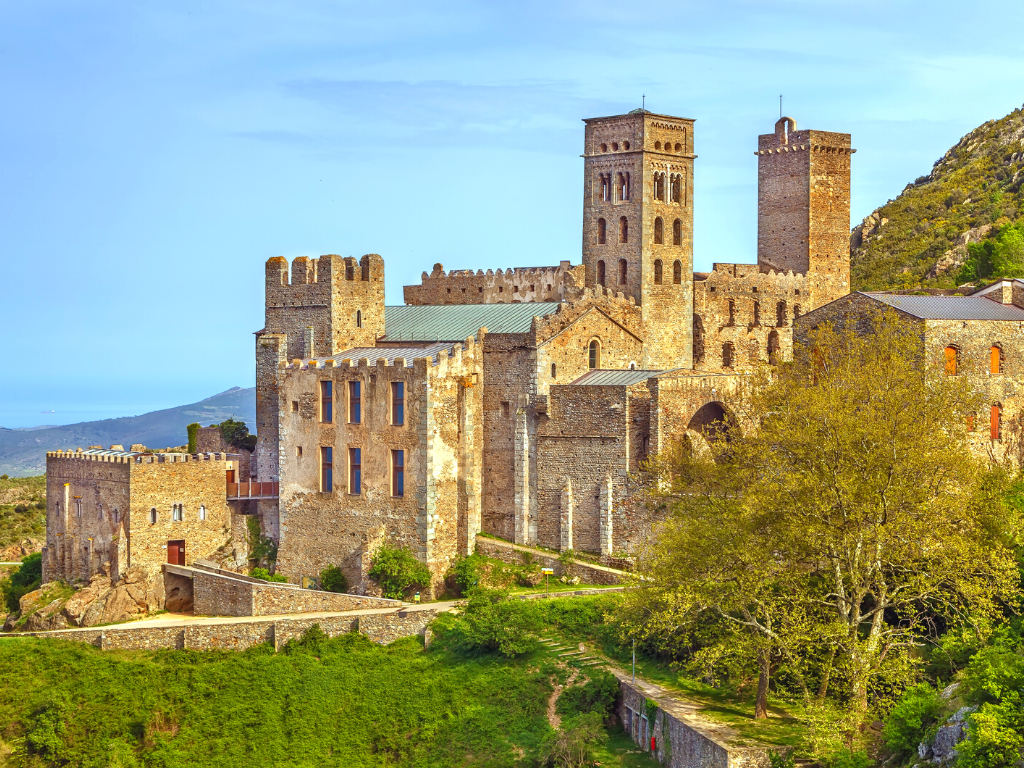
In the Rodes Mountains, outside of Girona, you’ll find the Monastery of Sant Pere de Rodes. The setting here is nothing short of breathtaking, with the monastery sitting in a secluded area in the mountain facing two scenic bays.
The exact origin of the Benedictine Monastery is unknown, but some say that monks in Spain carrying Saint Peter’s remains have something to do with it. There is, however, evidence that this monastery dates back to 878.
With restoration beginning in the mid 20th century, the Catalan Romanesque complex includes a church and belfry, monastic dormitories, dining hall, and several other rooms organized around a magnificent cloister.
Even more interesting, the monastery has many built in terraces that adapt to the slope of the mountain!
✔ Note: If you’re planning to rent a car to explore the nearby area, two free car parks within a 10 minute walk to this monastery in Spain.
Today, you can also find the headquarters of the Cabo de Creus Natural Park inside the complex. The park is certainly worth a visit while you’re in the area.
6. Monastery of Santo Estevo de Ribas de Sil, Ourense
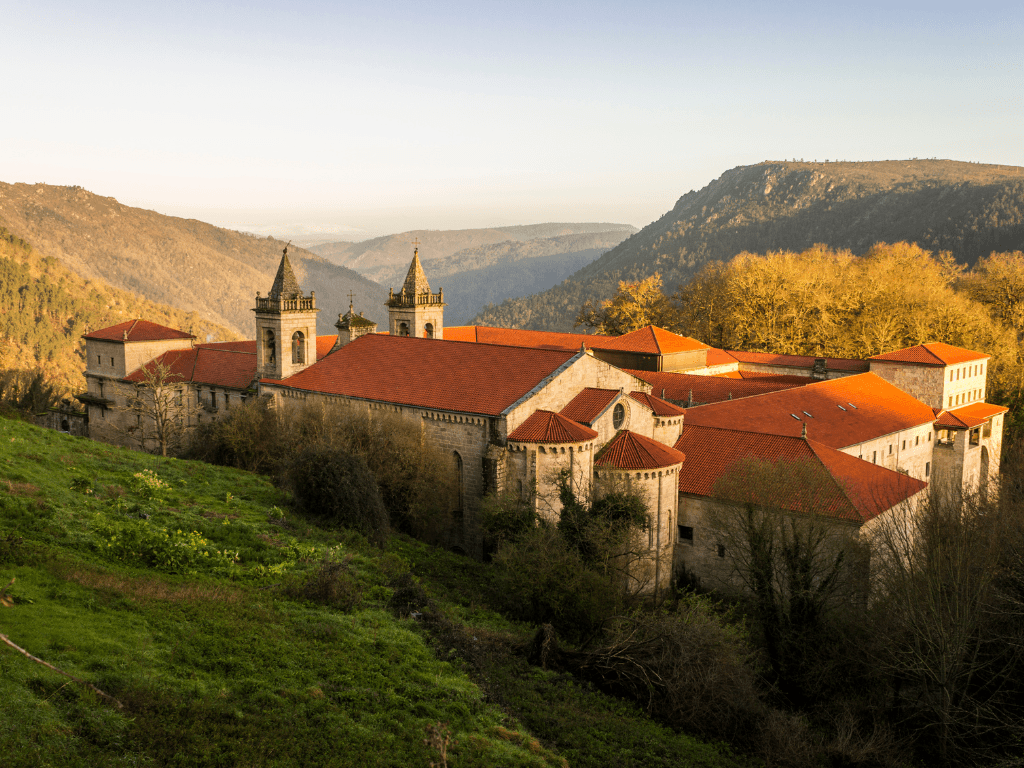
The hidden monastery of Santo Estevo de Ribas de Sil is one of the most spectacular of the rich heritage of Galicia. Much of the monastery (12-18th centuries) has been fully restored and renovated into a parador, a chic and luxurious hotel.
Santo Estevo is perfect for those looking to get away from it all and stay in a monastery in Spain. Located in the Ribiera Sacra, you’ll find the monastery tucked away in the mountains, surrounded by oaks and chestnut trees, and boasting fantastic views of the Sil river canyon.
Even if you don’t want to stay at the monastery, you can still visit the church with its two brightly colored stained glass windows, the cemetery, and the monastery itself.
If you do stay at the Spanish monastery, you’ll have access to the main cloister with its striking capitals.
At the hotel, you’ll also find a spa, cafés, and a restaurant with fine regional cuisine with views to die for.
There is a car park nearby, or you may visit by tourist train.
Parador de Santo Estevo Reviews
“Lovely signposted walk around the gardens with great views.” — Chris
“The monastery is gorgeous and full of history, not to mention the amazing views of the mountains.” — Aiste (Read more reviews)
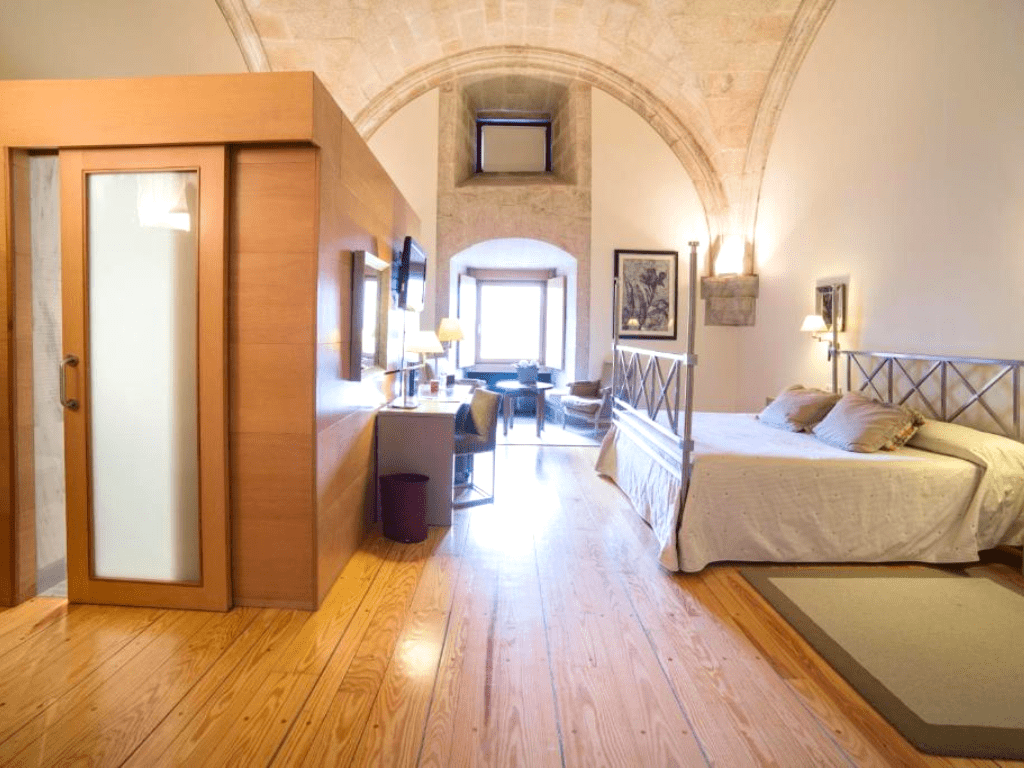
Book a stay the Parador de Santo Estevo!
✔ Modern & spacious
✔ Secluded forest
✔ Exceptional dinner
Book now
7. Royal Monastery of San Juan de la Peña, Aragón
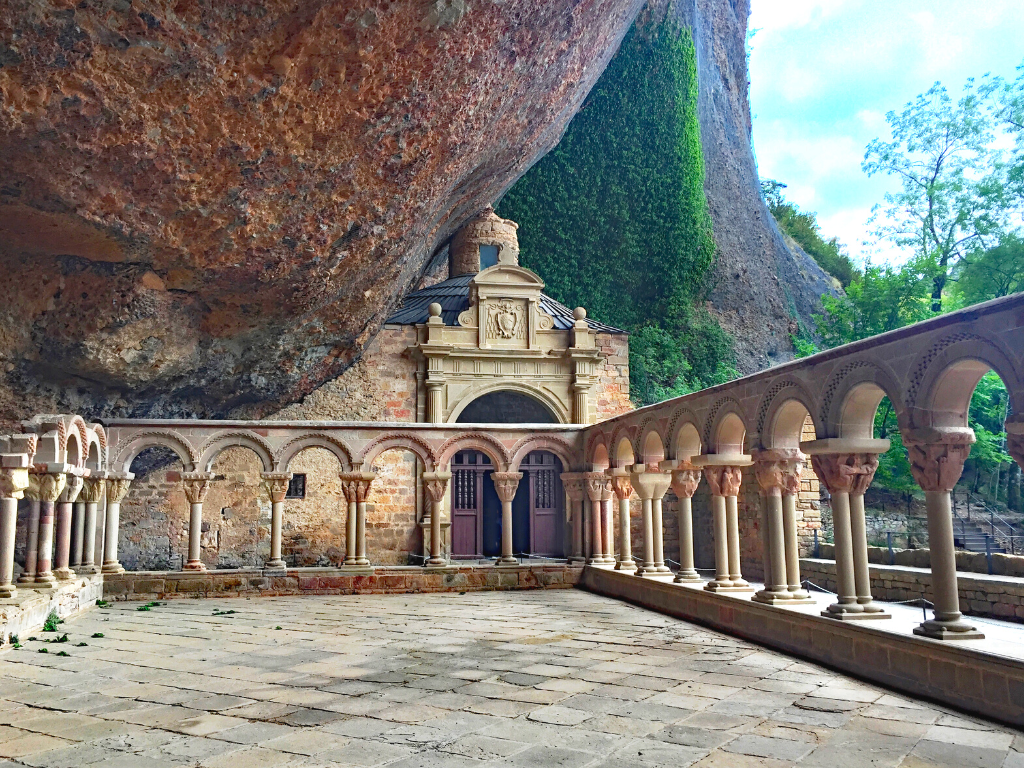
One of the most prominent monasteries in Aragón in the Middle Ages, the Monasterio Nuevo de San Juan de la Peña is a sight to see. Consisting of two monasteries (Old and New), you can find it in the middle of the Aragonese Pyrenees in the town of Santa Cruz de la Serós in the province of Huesca, Spain.
San Juan de la Peña literally means Saint John of the Cliff. Seeing as the church is partially carved into the stone of the cliff face, the name is fitting! Seeing this alone is worth the trip!
As you might expect, the Old Monastery shows a mix of styles as it was worked on throughout the ages (10-12th centuries). You’ll find some evidence of ancient Mozarab church and Romanesque influences throughout as well as in the magnificent cloister.
Nearby is the Baroque New Monastery, set in a serene protected landscape.
✔ The Spain monastery is most accessible by car from Pamplona or Zaragoza.
The origins of the San Juan de la Peña Monastery are somewhat of a mystery. While some connect it to the origins of the legendary kingdom of Aragón, others believe the Holy Grail made its way through there.
8. Monasteries of San Millán de la Cogolla, La Rioja
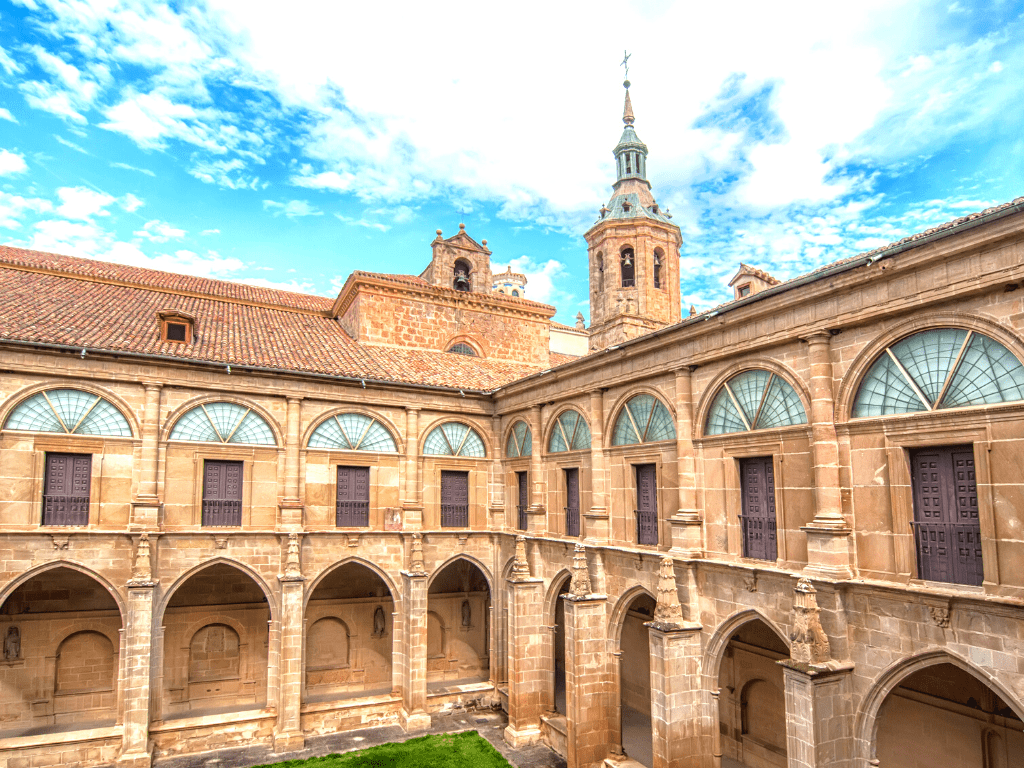
In the tiny town of San Millán de la Cogolla, La Rioja, on the Camino de Santiago pilgrimage trail, you’ll find two lovely Spanish monasteries: Yuso and Suso.
Although Yuso and Suso are lesser-known Spain monasteries, they aren’t any less beautiful or less historically significant. Constructed in between the 6th and 11th centuries, they say the first records in Spanish were found in these monasteries! Today, both monasteries are listed UNESCO World Heritage Sites.
Mozarabic Monasterio de Suso is a unique sight with ancient caves where hermits once lived. Inside the monastery, three large horseshoe arches await you as well as the tombs and various decor with depictions of plants.
Nearby you´ll find the Monasterio de Yuso, which is still a thriving monastic community today.
For those that want to stay in a monastery in Spain, you’ll be excited to find that part of the Yuso Monastery has been renovated into a hotel with the aim of not distorting the aspect or environment or the complex.
The rooms provide views of the surrounding mountains. And at the restaurant, you can enjoy local specialties accompanied by delicious Rioja wine.
Hostería del Monasterio de San Millán Reviews
“The room had two arches with shutters and balcony doors overlooking the mountain and forest. The view was beautiful and extremely tranquil. With the balcony doors open I could hear the creek and wind in the trees.” — Maureen
“This place is a hidden gem.” — Aglexi (Read more reviews)
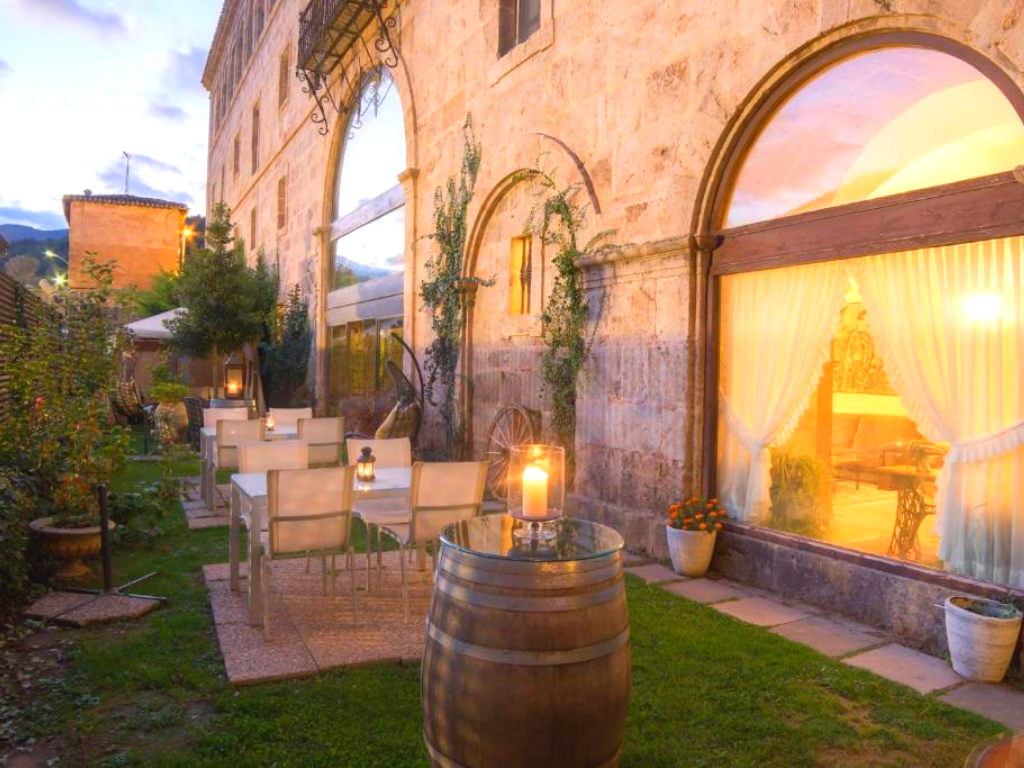
Want to stay at the monastery?
✔ Historic
✔ Spectacular views
✔ Rioja wine
Book now
9. Monastery of San Juan de los Reyes, Toledo
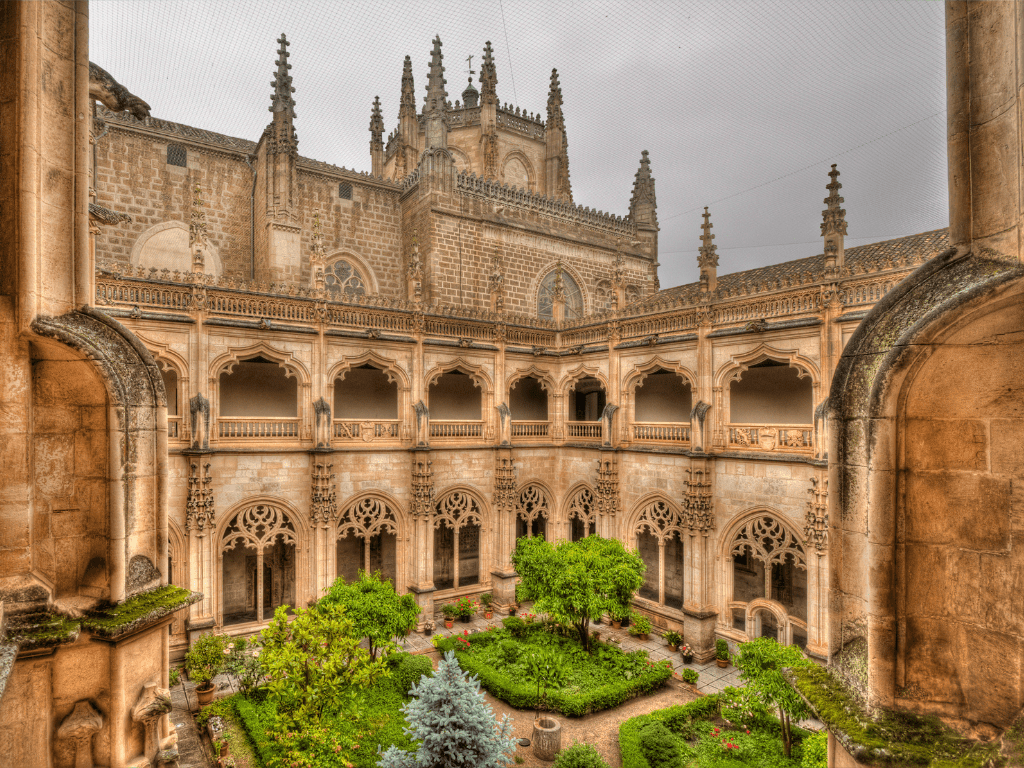
Toledo is famous for its magnificent cathedral, views, and artisan crafts and is well worth a day trip from Madrid. There, you’ll find the Isabellan Monasterio de San Juan de los Reyes.
Commissioned after the victory at the Battle of Toro in 1476, which represented a political victory for the Catholic monarchs at the time, a fire destroyed much of it.
Today, you’ll find a single nave, vault and a chapel, all intricately decorated. Of most interest is probably the two-story cloister. The ceiling is particularly beautiful as well as the small garden, lined with Isabellan arches.
Don’t forget to take a long look at the main façade with it’s memorable chains. They represent the Christians who were freed after Granada was conquered by the Catholic monarchs.
Tour the Monastery of San Juan de los Reyes on this must-do day trip from Madrid, which includes entry to seven different monuments in the city.
10. Monastery of San Jerónimo, Granada
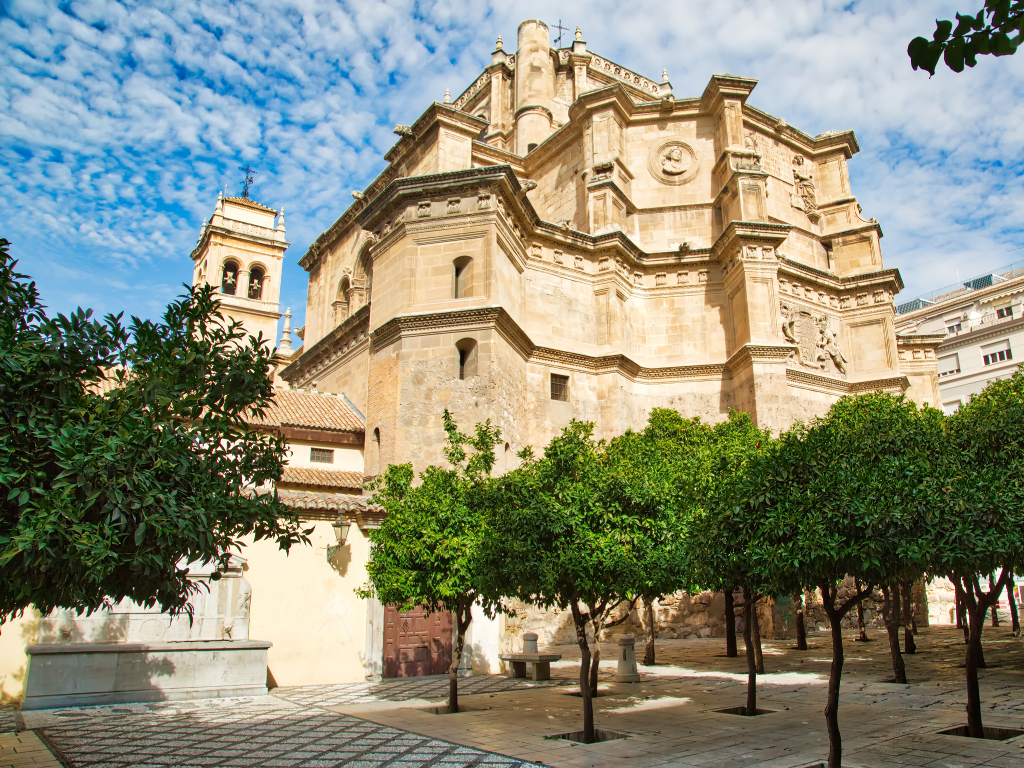
When visiting Granada, take a break from the hustle of the city, and visit the peaceful Monasterio de San Jerónimo. With construction beginning in 1496, it was the first monastery in Granada after the conquest of the city by the Christians.
The main attraction of the Monastery of San Jerónimo is the sacristy, adorned with more than a thousand carvings. It’s widely considered one of the best examples of Spanish Baroque style.
The monastery also has two cloisters, built around their own gardens. The main cloister has thirty-six semicircular arches. Each one pictures shields with the initials of kings and other important figures of the time.
The second cloister is now the enclosure of the monastery’s community of monks. Decorated with Gothic arches, it was once the residence of the Empress Isabella of Portugal for her wedding to Charles I of Spain.
During the Peninsular War, the French overtook the monastery. As a result, it lost many of its gorgeous ornaments as well as its tower (reconstructed in the 1980s).
If you’d like to get to know Granada’s monasteries in depth, consider a private tour of both the Monasterio de San Jeronimo and the fascinating Monasterio de Nuestra Señora de la Asunción “La Cartuja.”
What is a Monastery?
It’s clear that monastery buildings themselves are beautiful, but you may be wondering what exactly a monastery is.
Monasteries are buildings or complexes where monastics, monks, or nuns live, withdrawn from society. Generally, they devote themselves entirely to God through prayer, penance, solitude, and self-denial.
Monasteries have a long history — the first Catholic monasteries in Spain are rumored to have been built almost 2000 years ago. In their long existence, they have obviously seen their share of ups and downs.
Although many monasteries are no longer thriving, there are still monasteries in Spain—and in the world—in operation today.
Why to Visit a Monastery in Spain
With all the fun things to do and see in Spain, why visit a monastery in Spain? Here are a few reasons.

Peace & Tranquility
Whether you visit an operating monastery or not, they’re perfect places to get away from it all.
A Unique Stay
Some of the monasteries have been converted by the Spanish government into modern-day accommodations called paradors. Others open their doors to guests to share their traditions and make a little money. Yet others have been converted to hotels or hostels.
Truly, a monastery makes for a unique stay!
Religion
Learn more about religious traditions, and see what modern-day monastics are up to including singing chants and songs, making artisanal crafts, or baking homemade treats.
Architecture
Admire the beautiful buildings, explore hidden chambers, the courtyards, and cloisters to learn more about how and why monasteries were designed a certain way and how they have changed (or not!) over time
History
Find out the history of monasticism in Spain by traveling to some of its ancient monasteries.
Tips for Visiting Spain’s Monasteries
Here’s a quick list of tips for visiting monasteries.
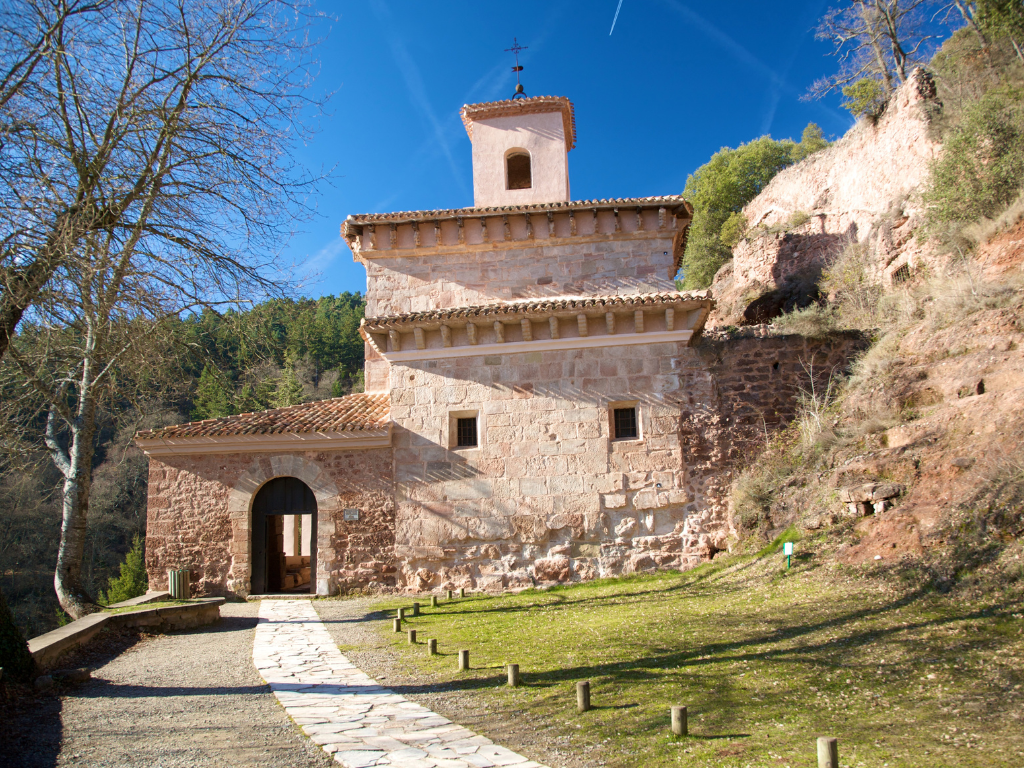
Be quiet
Within the monastery walls, refrain from having loud conversations or making noise. Remember, some of the monasteries have active religious communities living in them.
Dress modestly
While the rules aren’t always the same in every monastery, women should plan to cover their shoulders and knees. A pashmina or sarong is useful to carry with you.
Respect their community
Even if you aren’t of the same faith or values, show respect as a guest in the monastery.
Do not take photos
Some monasteries do not allow photos inside
Participate in the customs
If you are staying in an active monastery, you are expected to participate in some of the customs. For instance, attending a service or communal meal as a sign of respect for their hospitality.
Staying in a Monastery in Spain
If you’d like to stay in a monastery, you’re in luck. There are several different options when it comes to monastery stays in Spain.

The first choice for staying in monasteries in Spain is to stay in a luxury parador. Paradors include monasteries, convents, and other castles and fortresses that have been designated historical and converted into accommodations by the Spanish government.
As you can imagine, these luxury stays often come with a heftier price tag — but, are worth the splurge!
Next, there are many monasteries that have been converted into all levels of hotels and hostels. For example, the Hospedería San Martín Pinario in Santiago de Compostela is a budget-friendly hotel for visitors to the city.
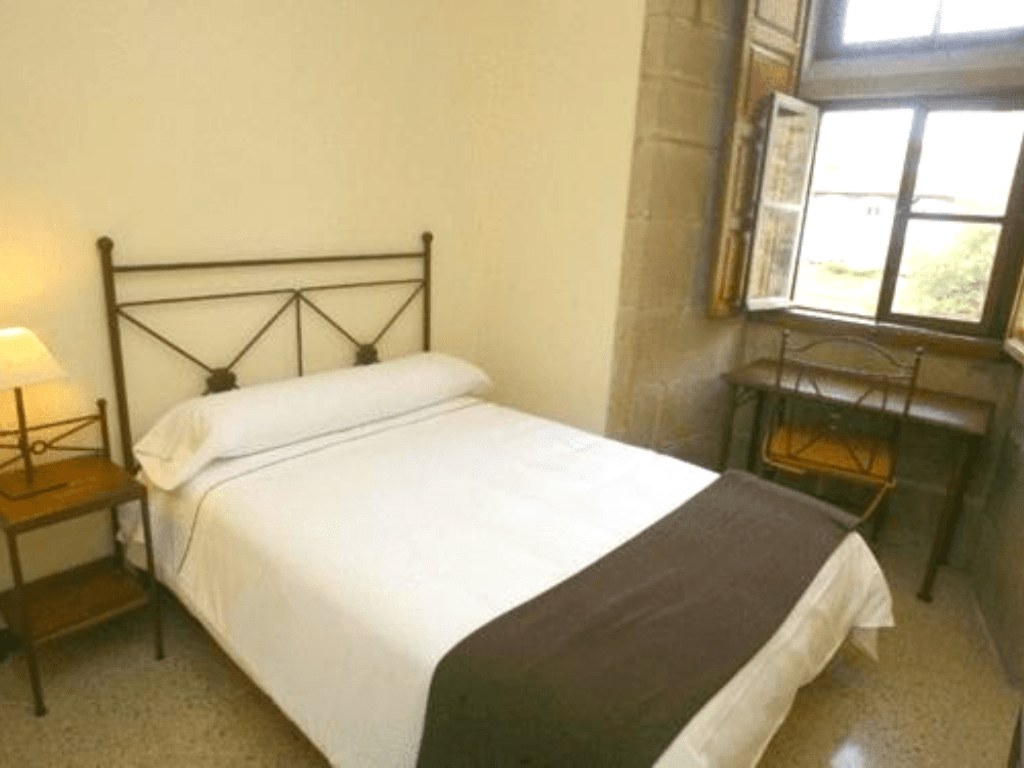
Stay at Hospedería San Martín Pinario!
✔ Pilgrim favorite
✔ Central location
✔ Breakfast
✔ Vaulted dining room
Book now
An example of a hostel is the Albergue Monasterio La Magdalena. It has been renovated into a pilgrim’s only hostel for hikers on the Camino de Santiago.
Lastly, some monasteries offering accommodation in Spain are active communities that open their doors to guests. To be frank, it may take a little digging to figure out how to book a monastery stay, and may involve just showing up during your next road trip!
Here are five Spain monasteries from this article that you can actually stay in!
✔ Impressive Grounds: Hospederia del Real Monasterio, Extremadura
✔ Peaceful Setting: Hostería del Monasterio de San Millán, La Rioja
✔ Chic & Luxurious: Parador de Santo Estevo, Galicia
✔ Best Guesthouse: Hospedería San Martín Pinario, Galicia
✔ Pilgrim’s Only: Albergue Monasterio de la Magdalena, Galicia
No matter what type of lodging in Spain’s monasteries interests you, you’ll have the opportunity to learn more about the historic, cultural, and spiritual significance of the properties in a tranquil setting.
How to Get to Monasteries in Spain
Depending on the monastery and your comfort level with Spanish transporation, we recommend these options to visit Spanish monasteries:
✔ Take a day trip — Search Viator for the best monastery day trips.
✔ Rent a car — Find a reliable car rental in Spain.
✔ Book a train or bus — Use Omio to find your own transport where available
Monasteries in Spain: Frequently Asked Questions
In this section, we’ll answer some FAQs about Spanish monasteries.
What is the oldest monastery in Spain?
Many different monasteries are claimed to be the “oldest monastery in Spain.” These are some of the monasteries that claim to be the oldest in Spain.
- Monastery of St. Victorián of Asan (11th Century)
- Benedictine Monastery of Sant Pau del Camp (977)
- Monastery of San Xulián de Samos (6th Century)
- Abbey of Santa María la Real de la Oliva (1145)
How many monasteries are in Spain?
There are 725 monasteries in Spain according to Statista.
Do you have to be religious to enter a monastery?
No, you do not need to be religious to visit a monastery. Monasteries are open to people of all cultures and faiths. However, plan to be respectful of the grounds, people, and traditions of the monastery—participating or politely declining if asked.
What is the biggest monastery in Spain?
The biggest monastery in Spain is the Royal Monastery of Santa María de Guadalupe, Extremadura.
What is an abbey in Spain?
An abbey is a group of buildings where a self-contained relgious community lives and works. Buildings typically include a monastery or convent and a cathedral (or other church or parish building). Within the community, you may find gardens and courtyards, hospitals, kitchens, etc. Abbeys are also under the direction of an abbot or abbess.
Are there monasteries along the Camino de Santiago pilgrimage route?
Yes, there are many churches, cathedrals, monasteries, and convents along the Camino de Santiago. A few favorites are the Yuso and Suso monasteries, Monasterio de la Magdalena, and the San Xulián Monastery.
Is Visiting a Monastery in Spain Worth It?
To sum up, we hope you enjoyed this monasteries in Spain list. Without a doubt, each one has a different history that makes it unique and is certainly worth a visit or a stay.
With ancient halls, communal areas, cloisters, gardens, chapels, artwork, and religious relics, it would take a lifetime to discover all the monasteries of Spain!
Not ready to plan your trip yet? Bookmark this page to refer to when ready.
